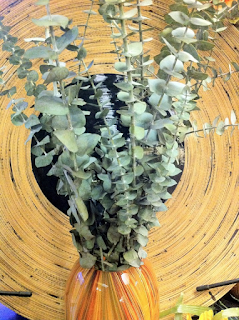As part of our 125th
Anniversary celebration at Stein Your Florist Co. we are sharing a year of
floral education, November 1, 2012 thru October 31, 2013. Each day we will post
something new on our Facebook page to share our knowledge of our favorite things,
flowers and plants and we'll be updating our blog every 5 days or so. No need
for pencils and notebooks, just sharing some simple lessons in floristry.
Day 121 - If you
receive roses with thorns, leave them. Removing the thorns wounds the stem. The
more wounds there are, the more likely the flower's life will be shortened.
"Barking" the stem ruins the vessels that transport water up the stem
to refresh the flower. It also creates an open wound through which bacteria can
enter. If you must remove a thorn, it's best to remove just a small piece of
the pointy tip. So be careful of those thorns and enjoy the beauty of the rose.
Day
122 – Kalanchoe is a genus of about 125 species of tropical, succulent
flowering plants, popular because of their ease of propagation, low water
requirements and wide range of available colors. In traditional medicine,
Kalanchoe species have been used to treat ailments such as infections,
rheumatism and inflammation. Kalanchoe extracts also have immunosuppressive
effects. One variety has even been recorded in Trinidad and Tobago as being
used as a traditional treatment for hypertension.
Day
123 - Of all the flowers typically seen in an American garden, the marigold
never disappoints. From its resilience, outlasting most other annuals well into
the fall months and thriving in even the hottest driest weather, to its intense
fiery color, the lowly marigold fills in the bare garden spots more efficiently
than many other flowers. While the marigold flower, closely associated with the
sun's energy, carries positive connotations, it has also been perceived through
the ages to possess some darker qualities. It can symbolize jealousy and
cruelty and represent sorrow and feelings of unrest during a sad time.
 Day
124 – Leaves are the plants’ food factory; producing carbohydrates by the
process of photosynthesis. The green pigment absorbs energy in the form of
sunlight and uses it to chemically combine carbon dioxide from the air with
water absorbed by the roots to make soluble sugar, which can then be converted
into insoluble starch and other products and subsequently stored as a potential
energy source.
Day
124 – Leaves are the plants’ food factory; producing carbohydrates by the
process of photosynthesis. The green pigment absorbs energy in the form of
sunlight and uses it to chemically combine carbon dioxide from the air with
water absorbed by the roots to make soluble sugar, which can then be converted
into insoluble starch and other products and subsequently stored as a potential
energy source.
Day
125 - In some countries of Europe, incurve chrysanthemums are symbolic of death
and are used only for funerals or on graves, while other types carry no such
symbolism; similarly, in China, Japan and Korea, white chrysanthemums are
symbolic of lamentation and/or grief. In some other countries, they represent
honesty. In the United States, the flower is usually regarded as positive and
cheerful, with New Orleans as a notable exception.




























